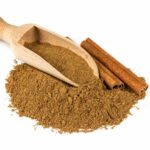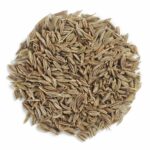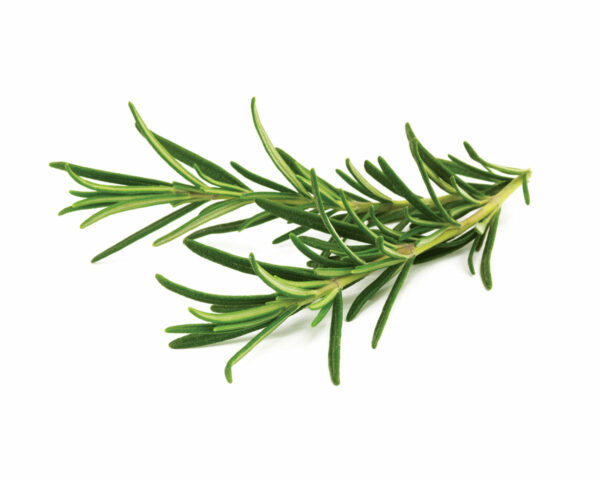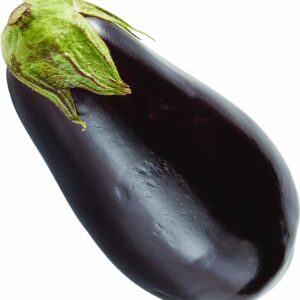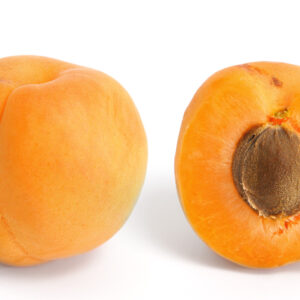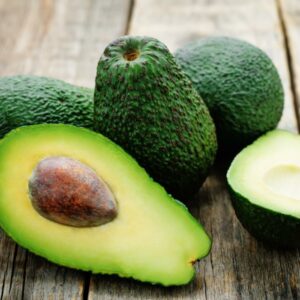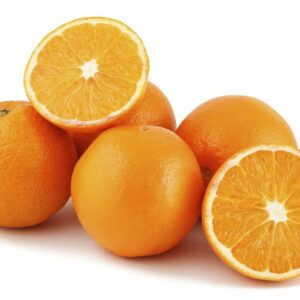Description
Looking like a small sprig from an evergreen tree the wonderful smell and assertively pine-like fragrance and pungent flavor of rosemary goes a long way to flavor to chicken, lamb, pork, salmon and tuna dishes as well as many soups and sauces. As an evergreen, rosemary is available throughout the year.
Rosemary grows on a small evergreen shrub belonging to the Labiatae family that is related to mint. Its leaves look like flat pine-tree needles, deep green in color on top while silver-white on their underside. Its memorable flavor and unique health benefits makes it an indispensable herb for every kitchen.
2.00 TBS
(4.20 grams)
GI: very low
This chart graphically details the %DV that a serving of Rosemary provides for each of the nutrients of which it is a good, very good, or excellent source according to our Food Rating System. Additional information about the amount of these nutrients provided by Rosemary can be found in the Food Rating System Chart. A link that takes you to the In-Depth Nutritional Profile for Rosemary, featuring information over 80 nutrients, can be found under the Food Rating System Chart.
- Health Benefits
- Description
- History
- How to Select and Store
- Tips for Preparing and Cooking
- How to Enjoy
- Nutritional Profile
- References
Health Benefits
The wonderful smell of rosemary is often associated with good food and great times. But it could just as easily be associated with good health. Rosemary contains substances that are useful for stimulating the immune system, increasing circulation, and improving digestion. Rosemary also contains anti-inflammatory compounds that may make it useful for reducing the severity of asthma attacks. In addition, rosemary has been shown to increase the blood flow to the head and brain, improving concentration. So, the next time you enhance the flavor of some special dish with rosemary, congratulate yourself for a wise as well as delicious choice.
Description
It is not surprising that the taste and aroma of the herb rosemary, historically used for strengthening the memory, is unforgettable. Rosemary has a unique pine-like fragrant flavor that is balanced by a rich pungency, a combination that evokes both the forest and the sea. Its memorable flavor and unique health benefits makes it an indispensable herb for every kitchen.
Rosemary grows on a small evergreen shrub belonging to the Labiatae family that is related to mint. Its leaves look like flat pine-tree needles, deep green in color on top while silver-white on their underside.
History
Although rosemary is native to the Mediterranean, it now grows throughout much of the temperate regions in Europe and America. Rosemary has been a prized seasoning and natural medicine for millennia. Part of rosemary’s popularity came from the widespread belief that rosemary stimulated and strengthened the memory, a quality for which it is still traditionally used. In ancient Greece, students would place rosemary sprigs in their hair when studying for exams, and mourners would also throw the fragrant herb into the grave of the deceased as a symbol of remembrance. In olde England, rosemary’s ability to fortify the memory transformed it into a symbol of fidelity, and it played an important role in the costumes, decorations and gifts used at weddings. Rosemary oil was first extracted in the 14th century, after which it was used to make Queen of Hungary water, a very popular cosmetic used at that time. In the 16th and 17th centuries, rosemary became popular as a digestive aid in apothecaries. Recently, as modern research focuses on the beneficial active components in rosemary, our appreciation for this herb’s therapeutic as well as culinary value has been renewed.
How to Select and Store
Whenever possible, choose fresh rosemary over the dried form of the herb since it is far superior in flavor. The springs of fresh rosemary should look vibrantly fresh and should be deep sage green in color, and free from yellow or dark spots.
Even through dried herbs and spices are widely available in supermarkets, explore the local spice stores in your area. Oftentimes, these stores feature an expansion selection of dried herbs and spices that are of superior quality and freshness to those offered in regular markets. Just like with other dried herbs, when purchasing dried rosemary, try to select organically grown herbs since this will give you more assurance that the herbs contain no pesticide residues and have not been irradiated (among other potential adverse effects, irradiating rosemary may lead to a significant decrease in its carotenoid content.)
Fresh rosemary should be stored in the refrigerator either in its original packaging or wrapped in a slightly damp paper towel. You can also place the rosemary sprigs in ice cube trays covered with either water or stock that can be added when preparing soups or stews. Dried rosemary should be kept in a tightly sealed container in a cool, dark and dry place where it will keep fresh for about six months.
Tips for Preparing and Cooking
Tips for Preparing Rosemary
Quickly rinse rosemary under cool running water and pat dry. Most recipes call for rosemary leaves, which can be easily removed from the stem. Alternatively, you can add the whole sprig to season soups, stews and meat dishes, then simply remove it before serving.
How to Enjoy
A Few Quick Serving Ideas
- Add fresh rosemary to omelets and frittatas.
- Rosemary is a wonderful herb for seasoning chicken and lamb dishes.
- Add rosemary to tomato sauces and soups.
- Even better than butter—purée fresh rosemary leaves with olive oil and use as a dipping sauce for bread.
For some of our favorite recipes, click Recipes.
Nutritional Profile
Rosemary is a good source of vitamin A (in the form of provitamin A carotenoid phytonutrients).
Introduction to Food Rating System Chart
In order to better help you identify foods that feature a high concentration of nutrients for the calories they contain, we created a Food Rating System. This system allows us to highlight the foods that are especially rich in particular nutrients. The following chart shows the nutrients for which this food is either an excellent, very good, or good source (below the chart you will find a table that explains these qualifications). If a nutrient is not listed in the chart, it does not necessarily mean that the food doesn’t contain it. It simply means that the nutrient is not provided in a sufficient amount or concentration to meet our rating criteria. (To view this food’s in-depth nutritional profile that includes values for dozens of nutrients – not just the ones rated as excellent, very good, or good – please use the link below the chart.) To read this chart accurately, you’ll need to glance up in the top left corner where you will find the name of the food and the serving size we used to calculate the food’s nutrient composition. This serving size will tell you how much of the food you need to eat to obtain the amount of nutrients found in the chart. Now, returning to the chart itself, you can look next to the nutrient name in order to find the nutrient amount it offers, the percent Daily Value (DV%) that this amount represents, the nutrient density that we calculated for this food and nutrient, and the rating we established in our rating system. For most of our nutrient ratings, we adopted the government standards for food labeling that are found in the U.S. Food and Drug Administration’s “Reference Values for Nutrition Labeling.” Read more background information and details of our rating system.
|
Rosemary, fresh
2.00 TBS 4.20 grams Calories: 6
GI: very low |
||||
| Nutrient | Amount | DRI/DV (%) |
Nutrient Density |
World’s Healthiest Foods Rating |
|---|---|---|---|---|
| World’s Healthiest Foods Rating |
Rule |
|---|---|
| excellent | DRI/DV>=75% OR Density>=7.6 AND DRI/DV>=10% |
| very good | DRI/DV>=50% OR Density>=3.4 AND DRI/DV>=5% |
| good | DRI/DV>=25% OR Density>=1.5 AND DRI/DV>=2.5% |
In-Depth Nutritional Profile
In addition to the nutrients highlighted in our ratings chart, here is an in-depth nutritional profile for Rosemary. This profile includes information on a full array of nutrients, including carbohydrates, sugar, soluble and insoluble fiber, sodium, vitamins, minerals, fatty acids, amino acids and more.
| Rosemary, fresh (Note: “–” indicates data unavailable) |
||
| 2.00 TBS (4.20 g) |
GI: very low | |
| BASIC MACRONUTRIENTS AND CALORIES | ||
|---|---|---|
| nutrient | amount | DRI/DV (%) |
| Protein | 0.14 g | 0 |
| Carbohydrates | 0.87 g | 0 |
| Fat – total | 0.25 g | 0 |
| Dietary Fiber | 0.59 g | 2 |
| Calories | 5.50 | 0 |
| MACRONUTRIENT AND CALORIE DETAIL | ||
| nutrient | amount | DRI/DV (%) |
| Carbohydrate: | ||
| Starch | — g | |
| Total Sugars | — g | |
| Monosaccharides | — g | |
| Fructose | — g | |
| Glucose | — g | |
| Galactose | — g | |
| Disaccharides | — g | |
| Lactose | — g | |
| Maltose | — g | |
| Sucrose | — g | |
| Soluble Fiber | — g | |
| Insoluble Fiber | — g | |
| Other Carbohydrates | — g | |
| Fat: | ||
| Monounsaturated Fat | 0.05 g | |
| Polyunsaturated Fat | 0.04 g | |
| Saturated Fat | 0.12 g | |
| Trans Fat | 0.00 g | |
| Calories from Fat | 2.22 | |
| Calories from Saturated Fat | 1.07 | |
| Calories from Trans Fat | 0.00 | |
| Cholesterol | 0.00 mg | |
| Water | 2.85 g | |
| MICRONUTRIENTS | ||
| nutrient | amount | DRI/DV (%) |
| Vitamins | ||
| Water-Soluble Vitamins | ||
| B-Complex Vitamins | ||
| Vitamin B1 | 0.00 mg | 0 |
| Vitamin B2 | 0.01 mg | 1 |
| Vitamin B3 | 0.04 mg | 0 |
| Vitamin B3 (Niacin Equivalents) | 0.07 mg | |
| Vitamin B6 | 0.01 mg | 1 |
| Vitamin B12 | 0.00 mcg | 0 |
| Biotin | — mcg | — |
| Choline | — mg | — |
| Folate | 4.58 mcg | 1 |
| Folate (DFE) | 4.58 mcg | |
| Folate (food) | 4.58 mcg | |
| Pantothenic Acid | 0.03 mg | 1 |
| Vitamin C | 0.92 mg | 1 |
| Fat-Soluble Vitamins | ||
| Vitamin A (Retinoids and Carotenoids) | ||
| Vitamin A International Units (IU) | 122.81 IU | |
| Vitamin A mcg Retinol Activity Equivalents (RAE) | 6.14 mcg (RAE) | 1 |
| Vitamin A mcg Retinol Equivalents (RE) | 12.28 mcg (RE) | |
| Retinol mcg Retinol Equivalents (RE) | 0.00 mcg (RE) | |
| Carotenoid mcg Retinol Equivalents (RE) | 12.28 mcg (RE) | |
| Alpha-Carotene | — mcg | |
| Beta-Carotene | — mcg | |
| Beta-Carotene Equivalents | 73.68 mcg | |
| Cryptoxanthin | — mcg | |
| Lutein and Zeaxanthin | — mcg | |
| Lycopene | — mcg | |
| Vitamin D | ||
| Vitamin D International Units (IU) | 0.00 IU | 0 |
| Vitamin D mcg | 0.00 mcg | |
| Vitamin E | ||
| Vitamin E mg Alpha-Tocopherol Equivalents (ATE) | — mg (ATE) | — |
| Vitamin E International Units (IU) | — IU | |
| Vitamin E mg | — mg | |
| Vitamin K | — mcg | — |
| Minerals | ||
| nutrient | amount | DRI/DV (%) |
| Boron | — mcg | |
| Calcium | 13.31 mg | 1 |
| Chloride | — mg | |
| Chromium | — mcg | — |
| Copper | 0.01 mg | 1 |
| Fluoride | — mg | — |
| Iodine | — mcg | — |
| Iron | 0.28 mg | 2 |
| Magnesium | 3.82 mg | 1 |
| Manganese | 0.04 mg | 2 |
| Molybdenum | — mcg | — |
| Phosphorus | 2.77 mg | 0 |
| Potassium | 28.06 mg | 1 |
| Selenium | — mcg | — |
| Sodium | 1.09 mg | 0 |
| Zinc | 0.04 mg | 0 |
| INDIVIDUAL FATTY ACIDS | ||
| nutrient | amount | DRI/DV (%) |
| Omega-3 Fatty Acids | 0.02 g | 1 |
| Omega-6 Fatty Acids | 0.02 g | |
| Monounsaturated Fats | ||
| 14:1 Myristoleic | — g | |
| 15:1 Pentadecenoic | — g | |
| 16:1 Palmitol | 0.00 g | |
| 17:1 Heptadecenoic | — g | |
| 18:1 Oleic | 0.04 g | |
| 20:1 Eicosenoic | 0.00 g | |
| 22:1 Erucic | — g | |
| 24:1 Nervonic | — g | |
| Polyunsaturated Fatty Acids | ||
| 18:2 Linoleic | 0.02 g | |
| 18:2 Conjugated Linoleic (CLA) | — g | |
| 18:3 Linolenic | 0.02 g | |
| 18:4 Stearidonic | — g | |
| 20:3 Eicosatrienoic | — g | |
| 20:4 Arachidonic | — g | |
| 20:5 Eicosapentaenoic (EPA) | — g | |
| 22:5 Docosapentaenoic (DPA) | — g | |
| 22:6 Docosahexaenoic (DHA) | — g | |
| Saturated Fatty Acids | ||
| 4:0 Butyric | — g | |
| 6:0 Caproic | — g | |
| 8:0 Caprylic | — g | |
| 10:0 Capric | 0.00 g | |
| 12:0 Lauric | 0.00 g | |
| 14:0 Myristic | 0.01 g | |
| 15:0 Pentadecanoic | — g | |
| 16:0 Palmitic | 0.08 g | |
| 17:0 Margaric | — g | |
| 18:0 Stearic | 0.01 g | |
| 20:0 Arachidic | — g | |
| 22:0 Behenate | — g | |
| 24:0 Lignoceric | — g | |
| INDIVIDUAL AMINO ACIDS | ||
| nutrient | amount | DRI/DV (%) |
| Alanine | 0.01 g | |
| Arginine | 0.01 g | |
| Aspartic Acid | 0.02 g | |
| Cysteine | 0.00 g | |
| Glutamic Acid | 0.02 g | |
| Glycine | 0.01 g | |
| Histidine | 0.00 g | |
| Isoleucine | 0.01 g | |
| Leucine | 0.01 g | |
| Lysine | 0.01 g | |
| Methionine | 0.00 g | |
| Phenylalanine | 0.01 g | |
| Proline | 0.01 g | |
| Serine | 0.01 g | |
| Threonine | 0.01 g | |
| Tryptophan | 0.00 g | |
| Tyrosine | 0.00 g | |
| Valine | 0.01 g | |
| OTHER COMPONENTS | ||
| nutrient | amount | DRI/DV (%) |
| Ash | 0.10 g | |
| Organic Acids (Total) | — g | |
| Acetic Acid | — g | |
| Citric Acid | — g | |
| Lactic Acid | — g | |
| Malic Acid | — g | |
| Taurine | — g | |
| Sugar Alcohols (Total) | — g | |
| Glycerol | — g | |
| Inositol | — g | |
| Mannitol | — g | |
| Sorbitol | — g | |
| Xylitol | — g | |
| Artificial Sweeteners (Total) | — mg | |
| Aspartame | — mg | |
| Saccharin | — mg | |
| Alcohol | 0.00 g | |
| Caffeine | 0.00 mg | |
Note:The nutrient profiles provided in this website are derived from The Food Processor, Version 10.12.0, ESHA Research, Salem, Oregon, USA. Among the 50,000+ food items in the master database and 163 nutritional components per item, specific nutrient values were frequently missing from any particular food item. We chose the designation “–” to represent those nutrients for which no value was included in this version of the database. |
||
References
- al-Sereiti MR, Abu-Amer KM, Sen P. Pharmacology of rosemary (Rosmarinus officinalis Linn.) and its therapeutic potentials. Indian J Exp Biol 1999 Feb;37(2):124-30. 1999.
- Calucci L, Pinzino C, Zandomeneghi M et al. Effects of gamma-irradiation on the free radical and antioxidant contents in nine aromatic herbs and spices. J Agric Food Chem 2003 Feb 12; 51(4):927-34. 2003.
- Ensminger AH, Ensminger, ME, Kondale JE, Robson JRK. Foods & Nutriton Encyclopedia. Pegus Press, Clovis, California. 1983.
- Ensminger AH, Esminger M. K. J. e. al. Food for Health: A Nutrition Encyclopedia. Clovis, California: Pegus Press; 1986. 1986. PMID:15210.
- Fortin, Francois, Editorial Director. The Visual Foods Encyclopedia. Macmillan, New York. 1996.
- Grieve M. A Modern Herbal. Dover Publications, New York. 1971.
- Kelm MA, Nair MG, Strasburg GM, DeWitt DL. Antioxidant and cyclooxygenase inhibitory phenolic compounds from Ocimum sanctum Linn. Phytomedicine 2000 Mar;7(1):7-13. 2000. PMID:12240.
- Malencic D, Gasic O, Popovic M, Boza P. Screening for antioxidant properties of Salvia reflexa hornem. Phytother Res 2000 Nov;14(7):546-8. 2000. PMID:12230.
- Wood, Rebecca. The Whole Foods Encyclopedia. New York, NY: Prentice-Hall Press; 1988. 1988. PMID:15220.
